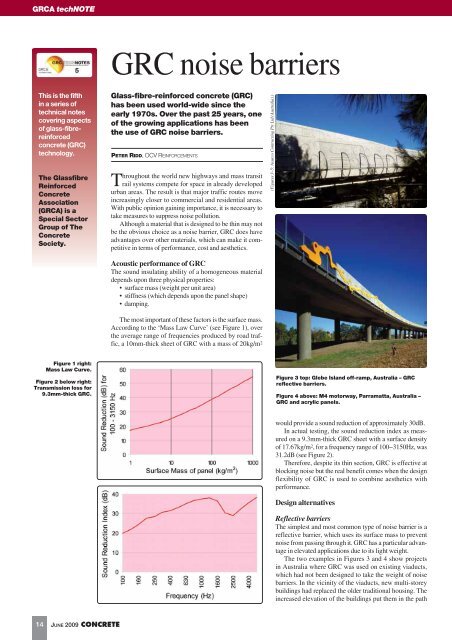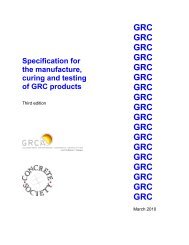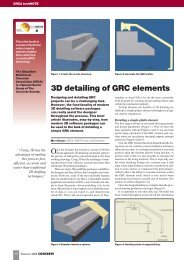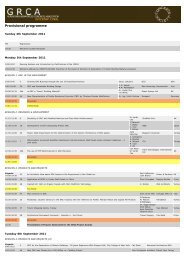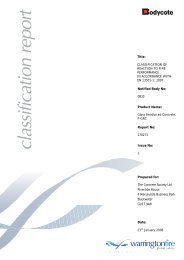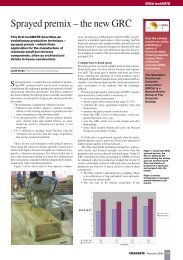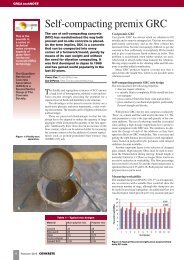GRC noise barriers - The Concrete Society
GRC noise barriers - The Concrete Society
GRC noise barriers - The Concrete Society
You also want an ePaper? Increase the reach of your titles
YUMPU automatically turns print PDFs into web optimized ePapers that Google loves.
<strong>GRC</strong>A techNOTE<strong>GRC</strong> <strong>noise</strong> <strong>barriers</strong>This is the fifthin a series oftechnical notescovering aspectsof glass-fibrereinforcedconcrete (<strong>GRC</strong>)technology.<strong>The</strong> GlassfibreReinforced<strong>Concrete</strong>Association(<strong>GRC</strong>A) is aSpecial SectorGroup of <strong>The</strong><strong>Concrete</strong><strong>Society</strong>.Glass-fibre-reinforced concrete (<strong>GRC</strong>)has been used world-wide since theearly 1970s. Over the past 25 years, oneof the growing applications has beenthe use of <strong>GRC</strong> <strong>noise</strong> <strong>barriers</strong>.PETER RIDD, OCV REINFORCEMENTSThroughout the world new highways and mass transitrail systems compete for space in already developedurban areas. <strong>The</strong> result is that major traffic routes moveincreasingly closer to commercial and residential areas.With public opinion gaining importance, it is necessary totake measures to suppress <strong>noise</strong> pollution.Although a material that is designed to be thin may notbe the obvious choice as a <strong>noise</strong> barrier, <strong>GRC</strong> does haveadvantages over other materials, which can make it competitivein terms of performance, cost and aesthetics.Acoustic performance of <strong>GRC</strong><strong>The</strong> sound insulating ability of a homogeneous materialdepends upon three physical properties:• surface mass (weight per unit area)• stiffness (which depends upon the panel shape)• damping.<strong>The</strong> most important of these factors is the surface mass.According to the ‘Mass Law Curve’ (see Figure 1), overthe average range of frequencies produced by road traffic,a 10mm-thick sheet of <strong>GRC</strong> with a mass of 20kg/m 2(Figures 3–5: Asurco Contracting Pty Ltd (Australia).)Figure 1 right:Mass Law Curve.Figure 2 below right:Transmission loss for9.3mm-thick <strong>GRC</strong>.Figure 3 top: Glebe Island off-ramp, Australia – <strong>GRC</strong>reflective <strong>barriers</strong>.Figure 4 above: M4 motorway, Parramatta, Australia –<strong>GRC</strong> and acrylic panels.would provide a sound reduction of approximately 30dB.In actual testing, the sound reduction index as measuredon a 9.3mm-thick <strong>GRC</strong> sheet with a surface densityof 17.67kg/m 2 , for a frequency range of 100−3150Hz, was31.2dB (see Figure 2).<strong>The</strong>refore, despite its thin section, <strong>GRC</strong> is effective atblocking <strong>noise</strong> but the real benefit comes when the designflexibility of <strong>GRC</strong> is used to combine aesthetics withperformance.Design alternativesReflective <strong>barriers</strong><strong>The</strong> simplest and most common type of <strong>noise</strong> barrier is areflective barrier, which uses its surface mass to prevent<strong>noise</strong> from passing through it. <strong>GRC</strong> has a particular advantagein elevated applications due to its light weight.<strong>The</strong> two examples in Figures 3 and 4 show projectsin Australia where <strong>GRC</strong> was used on existing viaducts,which had not been designed to take the weight of <strong>noise</strong><strong>barriers</strong>. In the vicinity of the viaducts, new multi-storeybuildings had replaced the older traditional housing. <strong>The</strong>increased elevation of the buildings put them in the path14JUNE 2009 CONCRETE
<strong>GRC</strong>A techNOTEof <strong>noise</strong> from the viaducts and hence <strong>noise</strong> <strong>barriers</strong> wererequired.In both applications, <strong>GRC</strong> was used in combinationwith other materials to give a more aesthetic result.However, reflective <strong>barriers</strong> do not exploit the full performancebenefits of <strong>GRC</strong>.If tall buildings are present, the use of reflective <strong>noise</strong><strong>barriers</strong> can actually increase the <strong>noise</strong> level at elevatedfloors, as the sound will be reflected back from the <strong>noise</strong><strong>barriers</strong> on the opposite side of the road.Dispersive <strong>barriers</strong>It is possible to reduce the problem of reflected <strong>noise</strong> byusing the design flexibility of <strong>GRC</strong> and creating a barrierwith a profiled face, which will disperse the <strong>noise</strong>. Inthis case the reflecting face may be angled to break up the<strong>noise</strong> by reflecting it upwards and along the road, and notback at the buildings opposite.Absorption <strong>barriers</strong><strong>The</strong> ultimate in <strong>GRC</strong> <strong>noise</strong> <strong>barriers</strong> is the absorption barrier.This effectively blocks the transmission of <strong>noise</strong>through the panel and also reflects very little <strong>noise</strong> backat the road.<strong>The</strong> design that has been most widely used is onethat was developed in Australia in the 1980s by RoclaComposites and the Victoria Roads Authority. Panels withthis design have been produced for contracts in Australia,Thailand and Malaysia. In Malaysia, the manufacturertook the novel approach of adapting the design of the<strong>GRC</strong> grill to produce a traditional Islamic pattern, whilestill retaining the acoustic performance of the panel (seeFigure 5).<strong>The</strong> key to the performance of the Australian absorptionpanel is its construction. A <strong>GRC</strong> grill with approximately50% voids on the face exposed to the traffic allowssound to pass into the panel. Within the panel an insulatingmaterial dissipates the acoustic energy of the sound waveswithout causing significant reflection. <strong>The</strong> back face ofthe <strong>GRC</strong> panel then helps to stop any remaining soundfrom escaping.In actual testing by the Acoustic Laboratories of CSIROin Australia, over the frequency range 100−3150Hz, the<strong>noise</strong> reduction coefficient (NRC) was found to be 0.95,and the sound transmission class was 34dB. For a panelweighing less than 70kg/m 2 this outperforms many other<strong>noise</strong> barrier systems currently available (see Figures 7and 8).Concluding remarks<strong>GRC</strong> is generally considered as a lightweight material dueto its thin section. However, despite this it has a high surfacemass, which makes it very efficient at blocking thepassage of <strong>noise</strong>. With no embedded steel reinforcement<strong>GRC</strong> is unaffected by de-icing salts. <strong>The</strong>refore combiningthese benefits with its design flexibility makes it an idealmaterial for use in <strong>noise</strong> barrier construction, particularlyon elevated structures. With highway construction placinggreater importance on aesthetics its use in this applicationis growing.■Figure 5 above left:<strong>GRC</strong> absorption panels,Malaysia.Figure 6 above right:<strong>GRC</strong> absorption panels,Australia.Figure 7 below left:Noise reductioncoefficient for <strong>GRC</strong>absorption panels.Figure 8 below right:Sound transmissionclass (STC) forabsorption panels is34dB.CONCRETE JUNE 2009 15


